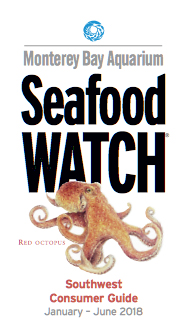The Desert Museum's Sustainable Seafood Program

The mission of the Desert Museum's Sustainable Seafood Program is to help consumers understand and recognize unsustainable and environmentally destructive seafood harvesting, and to encourage people to purchase sustainable seafoods in restaurants and markets, with a special focus on seafoods from the Gulf of California (Sea of Cortez). The Desert Museum has partnered with the Monterey Bay Aquarium to research and produce a Gulf of California (Southwest) Seafood Watch Guide. Use this guide and help make a difference! Your wise choices will help create a healthier Gulf of California, and healthier oceans worldwide. Pocket-size Seafood Watch Guides are available at the Desert Museum's ticket window, and can be downloaded here. For more information about the Monterey Bay Aquarium's Seafood Watch Program, or to view the research summaries upon which the Gulf of California Seafood Watch Guide is based, visit this web site.
Over the past two decades, the world's fishing fleets have come to employ increasingly sophisticated technology to locate and harvest seafood (finfish and shellfish), including sonar, GPS, satellite data, seafloor scouring devices, long-lines, and highly effective gill nets. Today, as a result, 80 percent of the world's commercially-fished species are being fished at or beyond the brink at which their populations can sustain themselves (i.e., beyond sustainable levels). Annual seafood catches have now declined worldwide despite increased efforts by fishers. In addition, the sea's top predators have been reduced in numbers (by over-fishing) as much as 90 percent. Further, poorly designed coastal aquaculture farms are destroying the world's shores. Humans are now over-fishing nearly every commercial marine species, disrupting natural ocean ecosystems, altering oceanic food webs, and destroying coastlines around the world. And, a third of all the commercial seafood harvested in the world goes to fishmeal and fish oil, not to feed hungry humans.
Nearly one-third of the seafood consumed in the world is now farm raised. Aquaculture has the potential to relieve pressures on declining wild populations and create sustainable seafood production - if it is done right. Unfortunately, this is rarely the case. Most saltwater fish farming further threatens wild fish stocks and disrupts or destroys natural habitats. The culture of carnivorous seafood (e.g., shrimp, salmon) requires catching huge quantities of wild fish to feed them. It takes over 3 pounds of wild-caught fish to raise one pound of farmed salmon or shrimp, resulting in a net loss of fish from the sea. About a quarter of all seafood caught in the wild is converted into fishmeal to feed farmed fish and shrimp. Farmed fish frequently escape into waterways or to the sea, polluting the gene pools of wild species and introducing exotic diseases. Many farms also release large amounts of untreated waste into surrounding waters, waste that contains fecal matter, drugs, and other chemicals used in aquaculture facilities. Non-domestic shrimp farms built on the coast typically degrade or destroy natural habitat, such as coastal estuaries and lagoons, and mangrove forests.
For all these reasons, herbivorous fish (those species low in the food chain), such as catfish and tilapia, are the best options for harvesting and for consumers. If you must buy shrimp, buy U.S. wild-caught or farmed shrimp where strict guidelines are in place. Avoid purchasing all top carnivores ("apex predators"), such as grouper, sea bass, corvina, snapper, orange roughy, rockfish, and sharks. These fish are long-lived and commonly harvested before they have spawned. Avoid purchasing all seafood dredged from the sea floor, such as clams, oysters, scallops and shrimps (purchase hand or shovel-harvested shellfish). The dredging operations disrupt the seabed ecosystem and, in some cases, totally destroy it. Avoid fish taken by long-lines. This non-discriminating fishing method kills hundreds of thousands of non-target organisms, including sea turtles and porpoises, and have largely been responsible for the plummeting world bluefin tuna populations (bluefin tuna catch has fallen 90 percent since 1963).
Download a copy of the article "Seafood and the Sea of Cortez" (PDF)